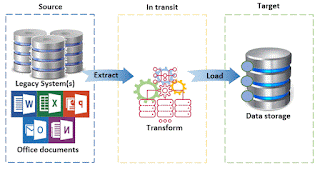ETL (Extract, Transform, Load) processes, technologies or tools are about extracting data from one or more data sources via a set of queries, performing changes on the data via conversions, aggregations, mappings or other types of transformations, respectively loading the data into target tables or other type of repositories. Thus, an ETL process allows moving and transforming data between predefined data structures on an ad-hoc basis or as part of stable repetitive processes, which makes ETL ideal for data warehousing, data integrations, data migrations or similar scenarios.
Extract: The extraction of data is done typically based on SQL queries from relational databases or any OLEDB or ODBC-based data repositories including flat or MS Office files, though modern ETL tools can support other type of queries (CAML, XQuery, DAX) or even NoSQL architectures (Handoop). This allows addressing a wide range of requirements, the complexity of the logic depending on the functionality provided by the query languages, respectively the extraction functionality available.
Transform: The transformation logic can be implemented based on the functionality provided by the ETL tool, and can involve after case any combination of aggregates, conditional splits, merges, lookups, multicasts, pivoting/unpivoting, cleansing, data conversions, sampling, mapping or any other transformations that can be performed on an in-transit dataset. On the other side, quite often the same can be achieved with the help of SQL-based manipulations directly in the extraction logic or later in the process. SQL can prove to be occasionally faster and more flexible than the transformations provided by the ETL tool, however despite the overlaps, the two approaches can complement each other when used adequately.
Load: The load is usually just a dump of the data into one or more final or intermediary tables with predefined structures. Unless the data don’t match the data type, format or further defined constraints, the load seldom involve further challenges as long the solution was designed adequately.
Within the logical model, extract, transform and load can be considered as process by themselves. Within the object model provided by the ETL tool, they are considered in the mentioned sequence within a data flow, which within a set of workflow constraints defines how the data move through the pipeline – the sequence of processing steps considered. The basic unit of work is the data flow and the workflow it belongs to, unit that can be encapsulated in one container for easier management or simply convenience. Several containers can be linked within a workflow to create more complex behavior.
The data flows and workflow constraints, together with the supporting connections and containers form an ETL package, the main unit of work for encapsulating and running ETL logic. ETL packages are scheduled and run as fit for the purpose.
With the right design, these building blocks allow enough flexibility in handling ad-hoc requests or of building complex solutions. This involves decisions on how to partition the ETL packages, respectively the data flows, in which order they should be run, where and in which sequence the data should be transformed, how to handle exceptions, how to build eventually intermediary data repositories, how to handles audit requirements, and so on. Each of these choices can prove to be important.
The knowledge of the ETL architecture and functionality is quintessential in providing the right solution for the problem considered, however once the basics were understood the challenges typically reside in understanding the source and/or target structures, the logical and physical entities available, identify the way the data can be partitioned horizontally or vertically, respectively what type of transformations are required for moving the data, as required by the solution.
Previous Post <<||>> Next Post




